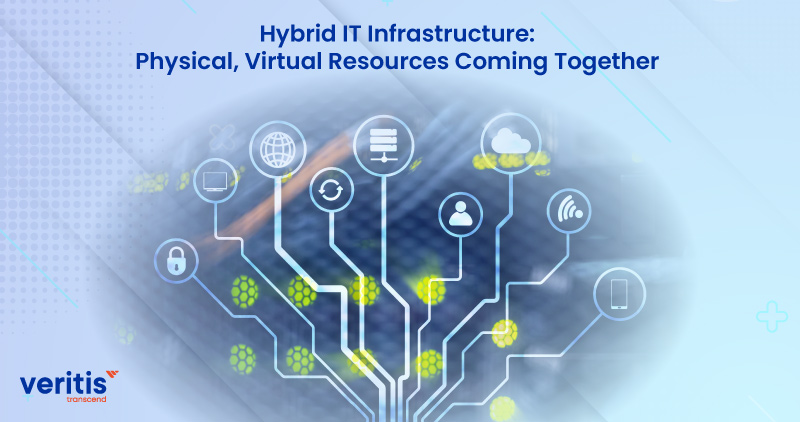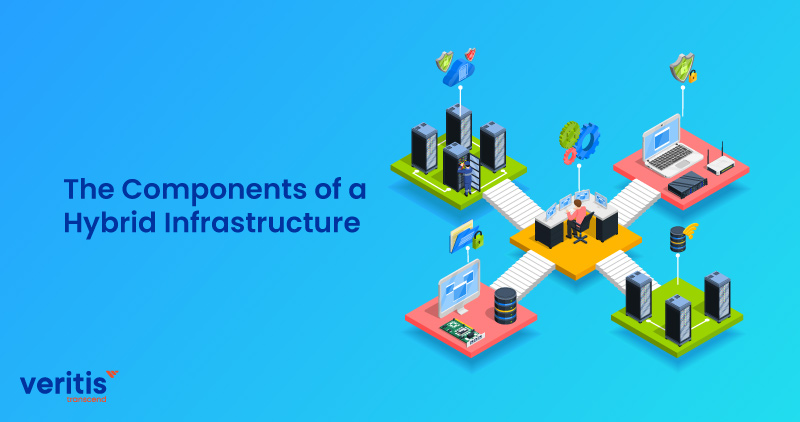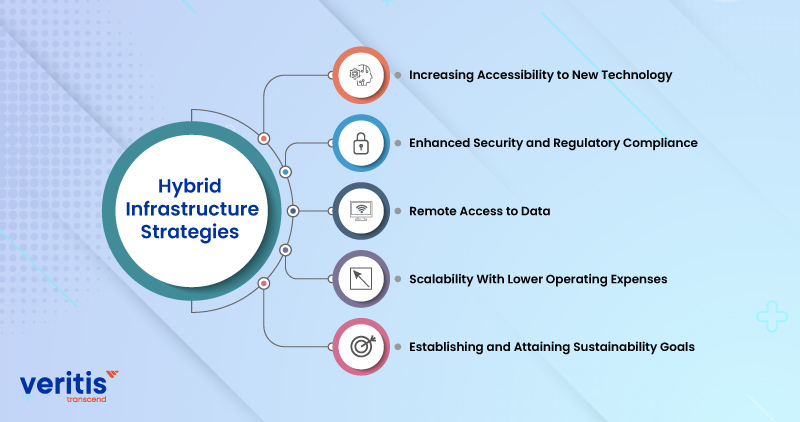
The replacement of physical data centers and legacy systems is one topic that has become a significant point of discussion with the emergence of innovative computing solutions like cloud and virtualization.
With the internet revolution and ever-increasing digital solutions, many firms started adopting intelligent solutions, eventually becoming a concern for traditional physical data centres and other hardware resources.
Wiping off this concern, here is one trending IT concept that is coming as a cohesive resultant of physical and virtual software models. And the industry calls it ‘Hybrid IT Infrastructure‘.
The advent of cloud computing sparked the emergence of hybrid IT infrastructure, one of the biggest operational revolutions in IT history. With quick access to expanded or decreased capacity at the precise level required, the cloud has revolutionized how businesses function and scale. In addition, this has freed up equipment budgets from paying for overprovision in the event of shrinkage or accommodating expansion.
On-premises data centers are still a part of the picture, but there is no longer an either-or choice regarding application strategy and cloud/on-prem services. A hybrid IT infrastructure strategy is becoming increasingly popular among enterprises, combining on-premises data centers, private clouds, and public clouds in various locations.
A hybrid architecture allows businesses the flexibility of a hyperscale environment to keep mission-critical data on private cloud infrastructure for improved protection while shifting power-intensive activities to public cloud services to optimize energy consumption.
Hybrid cloud model systems combine the best features of on-premises infrastructure, private and public clouds. But what exactly is a hybrid cloud infrastructure, and how is it implemented? Hybrid clouds combine on-premises, private, and public cloud computing to create a single, flexible, affordable IT infrastructure.
A Snapshot
As the name suggests, hybrid IT infrastructure typically involves collaboration between physical and virtual resources, making it a cohesive physical-virtual model. While promoting the need for innovative virtual solutions, hybrid IT infrastructure maintains a balanced stand for physical resources serving many IT purposes.
Rather than replacement of legacy systems, the hybrid cloud model proposes more consolidated and enhanced physical data centers. Upon effective implementation, the hybrid cloud model offers a high level of flexibility in developing new processes and deploying profitable business solutions.
An adequately managed Hybrid IT infrastructure model facilitates a customer-centric approach while easing ways to run complex operations, colossal databases, and critical applications like Big Data. With the increasing cloud adoption across firms, the IT industry estimates that more than 60 percent of firms are keen on adopting Hybrid IT infrastructure solutions in the future.
Overall, three factors make salient features of a Hybrid IT Operations model:
- Simplified application and server deployment
- Secured data and infrastructure security
- Effective resource management
The Components of a Hybrid Infrastructure

A hybrid infrastructure combines on-premises data centers with private, public, or clouds. Depending on the strategic business requirement, the tactical needs, and the desired output, enterprise systems, and applications can be installed on any of these settings. For instance, a company may save costs by migrating most business operations to the cloud or hybrid cloud architecture.
Implementing a cloud-based employee management solution that is powered by data from legacy systems may be a good idea for a company with a fast-growing workforce. However, it’s also possible that a company will realize it needs to allow employees to use their own devices (BYOD) to access specific applications. When this happens, it’s critical to consider how to manage systems and applications in a hybrid integration platform environment.
Businesses that run purely on-premises or in the cloud are uncommon, especially those that have been in operation for a while. However, even the most conventional organizations will adopt these best-of-breed software solutions due to the increase and proliferation of best-of-breed SaaS apps. Additionally, it is essentially unfeasible for most medium- to large-sized businesses to install all their systems on a public cloud.
The requirement for a hybrid infrastructure is a business need for most businesses. Therefore, any integration solution a firm chooses must function across all these contexts since corporate integration is essential to make all these systems work together.
Useful link: Cloud Infrastructure Automation: The Imperative for Cloud Success!
Benefits of Hybrid IT
Organizations that need to manage a combination of conventional on-site and hybrid cloud deployments can benefit from hybrid IT solutions in multiple ways:
1) Averts Cloud Migration Concerns
You avoid the hassle of moving traditional apps to the cloud in the short run. It is unnecessary to incur the expense and burden of moving heavily dependent legacy workloads at the expense of the innovation and agility that a hybrid cloud model architecture may eventually bring.
Since the complexity of the infrastructure can result in costly service interruptions, a stable IT environment continues to function as intended. Furthermore, IT workloads running from the cloud for complex legacy, troubleshooting, and maintenance can be challenging due to restrictions in visibility, control, and service levels of cloud systems.
2) Designing in security
Every organization must prioritize information security. But unfortunately, migration to the cloud adds a new hybrid cloud security risk that legacy systems might be unable to handle.
Furthermore, organizations fully control and manage any hybrid cloud security-sensitive data stored in on-site data centers. The vendor must anticipate the risks that come with moving workloads to the cloud and must be trusted to be mitigated, including:
- Insider threats
- Cyberattacks from outside
- Power failures
3) Scale Economies
The cost of moving all IT workloads to the cloud can be high. The entire cost of owning a cloud service may be much greater than running a data center, particularly for businesses wishing to grow their commercial services quickly. These companies have a few options on how to run their own data centers in place of working with external cloud vendors:
- Locally based network
- Cloud-based
- Virtualized
Useful link: Cloud, Hybrid IT Among Top Priorities for Information Technology Business
Hybrid Infrastructure Strategies

1) Increasing Accessibility to New Technology
Employing hybrid cloud management gives businesses options in the technologies they choose to support application workload. Applications can be set up in the environment that offers the most efficiency, the lowest price, and the most dependable service. These improvements give organizations with flat OPEX expenses and operational performance considerable competitive advantages.
Businesses can prevent vendor lock-in and increase access to developing technologies by integrating several public cloud services. This helps them avoid vendor lock-in and save capital and operational expenses wherever possible.
2) Enhanced Security and Regulatory Compliance
Organizations may secure various data streams more easily with the help of hybrid cloud management solutions. With on-premises infrastructure, vital or sensitive data can maintain secure from potential assaults and secured according to a company’s preferences. Meanwhile, public cloud storage can quickly and easily analyze sensitive data.
Companies can store this data using hybrid cloud solutions without constructing data centers in each nation where they collect data. They can adhere to data localization standards and maintain data security thanks to public cloud regions.
3) Remote Access to Data
Any organization that uses remote working environments must provide remote access to data and apps. Access to on-premises stored data and applications may be unnecessarily complicated, challenging, or subject to lag times that are intolerable for an organization’s speed of operation.
In contrast, hybrid infrastructures allow anyone within an organization with the proper authorization to quickly access data and applications hosted in the cloud, regardless of location. As a result, hybrid infrastructures significantly benefit companies operating across foreign locations by cutting costs for on-prem data centers while exceeding them in terms of service and application accessibility.
4) Scalability With Lower Operating Expenses
The capacity to achieve strategic goals at lower costs has been a significant factor in adopting hybrid cloud infrastructures.
Businesses that can reduce operating expenses are more successful. Public clouds give them access to scale without incurring CAPEX (capital expenditures) or the administrative and technical costs associated with growing on-site data centers.
Firms must prepare for expansion. Building enough on-site infrastructure in advance of peak demand could be more efficient. This capacity must be utilized when there is a frequent need, using up the IT budget.
5) Establishing and Attaining Sustainability Goals
Sustainability is now both an economic and an environmental necessity for many businesses. The UN’s Sustainable Development Goals and the ESG criteria are only two examples of the principles businesses and management teams are expected to use when setting goals for boosting sustainability.
Sustainability is becoming both a business and environmental necessity for many organizations. Experts urge businesses and management teams to develop goals for improving sustainability. A hybrid infrastructure strategy can contribute significantly to sustainability goals by decreasing e-waste and avoiding the need for more natural resources to achieve the same business goals.
Conclusion
A hybrid IT infrastructure has become more and more common as a result of the many advantages it offers. However, it’s crucial to emphasize that the specifics of your system’s setup will determine how much your decision to switch to a hybrid infrastructure strategy will pay off.
The cloud has enabled an increasing employee to access data from a distance. However, if devices are not set up and appropriately secured to allow flexible data storage and transfer, firms still run the danger of overspending.
Overall, hybrid IT solutions infrastructure holds a promising future and is the next big thing, an effective combination of traditional and innovative solutions. Veritis, the Stevie Award winner, provides to leverage its expertise in IT infrastructure solutions to achieve further financial and sustainability improvements.
Got Questions? Schedule A Call
Also Read:
- Achieve Data Agility with Hybrid Cloud Database Strategy
- Google’s Anthos: The Hybrid and Multi-Cloud Platform That You Need
- Hybrid Cloud Model: 6 Security Risks and Ways to Overcome!
- Cloud, Hybrid IT Among Top Priorities for Information Technology Business
- Business Continuity Planning: How C-suite Can Build Human Resilience?
- Which AWS Cloud Management Tools Should You Use to Manage Your Business